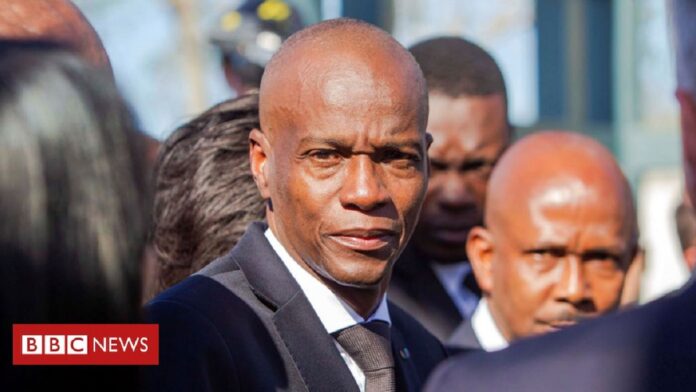Haiti’s President Jovenel Moïse was assassinated in his private residence in the capital, Port-au-Prince, on 7 July.
Police say a group of mercenaries, most of them Colombians, was behind the attack which they suspect a Haitian doctor of ordering as part of a plot to become president.
Here is what we know so far.
What happened?
Mr Moïse, 53, was shot dead inside his home in the Pelerin 5 neighbourhood, in the hills above Port au Prince. Police say the murder happened at 01:00 local time (05:00 GMT) on 7 July.

The president was shot 12 times and had bullet wounds to his forehead and several to his torso.
His left eye had been gouged out and bones in his arm and in his ankle had been broken, according to one of the judges conducting the investigation.
He died at the scene and was found lying on the floor on his back, his shirt soaked in blood.
The First Lady, Martine Moïse, was also shot but survived.
Who shot him?
Haitian police say a group of mainly foreign mercenaries – 26 Colombians and two Haitian Americans – made up the group that carried out the killing.
An investigating judge said the two Haitian Americans had told interrogators they had been hired as interpreters on the internet.
The two allege that they did not know there was a plan afoot to kill the president but believed they were to act as interpreters when he was arrested. Haiti’s official languages are Creole and French, while the Colombian suspects speak Spanish.
One of the Haitian Americans said he had been given what he believed was an arrest warrant for the president.
Most of the Colombian detainees have been identified as former soldiers, including a lieutenant-colonel.
Haitian police paraded them before the media.
Family members told Colombian media their loved ones had told them that they had been hired “to provide security” in Haiti.
After retiring from the army, many Colombian soldiers go on to work for security firms abroad, mainly in the United Arab Emirates, where they are valued for their training and experience in fighting armed groups.
Who hired the Colombians?
Haitian police announced on 11 July they had arrested a “key suspect” in the president’s assassination.
Police chief Léon Charles alleged that Haitian national Christian Emmanuel Sanon had hired 26 of the 28-strong hit squad through a Miami-based company called CTU, run by Venezuelan national Tony Intriago.
Mr Charles said Mr Sanon was “the first person” that one of the Colombian suspects had called when police surrounded them.
He added that the 63-year-old doctor, who resides in Florida, had arrived in Haiti on a private jet in early June with “political motives”.
Mr Charles said that police had found weapons, ammunition and a Drug Enforcement Administration cap in his possession.
The police chief suggested that the Colombians might have been duped by Mr Sanon, who was planning to become Haiti’s president.
“The initial mission that was given to these assailants was to protect the individual named Emmanuel Sanon, but afterwards the mission changed,” he said without clarifying if all or any of the suspects had been briefed about the changes
In total, 44 people have been arrested in connection with the inquiry into the assassination of Moïse and a number of others are being sought.
One of those on the run is Joseph Felix Badio, a former official in the justice ministry’s anti-corruption unit.
How did the assailants gain access?
Video footage, not independently verified but thought to have been taken by residents, shows armed men dressed in black arriving in several vehicles.
A man, thought to be a security guard, appears to have been forced to lie face down in the street while another man can be heard shouting in English over a loudspeaker, “DEA [US Drug Enforcement Administration} operation, everybody stay down!”
Haiti’s ambassador to the US, Bocchit Edmond, said that while the attackers had disguised themselves as US drug agents, he believed there was “no way” they really were US agents.
Officials say that the ground between the property’s gatehouse and the residence was littered with cartridge cases, indicating that multiple shots were fired.
Yet the only people injured by bullets were the president and his wife, a fact which has raised questions about the possible complicity of the president’s guards.
How did the assailants flee the scene?
The group seems to have met little or no resistance inside the residence or during their initial getaway.
Two domestic staff where tied up and the presidential couple’s adult daughter, Jomarlie Moïse, hid in her brother’s bedroom and was unhurt. She and her two brothers – who were not in the residence at the time of the attack – are in “safe locations”, according to officials.

The timeline immediately after the assassination is not very clear.
Haiti’s police chief announced some 24 hours after Mr Moïse’s assassination that a fierce gun battle was under way in the Pelerin neighbourhood.
“We blocked [the suspects] en route as they left the scene of the crime. Since then, we have been battling them,” said Chief Léon Charles.
Some of the suspects were reportedly tracked down to a house nearby, which was then surrounded by police, and where the gun battle the police chief referred to is believed to have taken place.
A group of 11 fled to Taiwan’s diplomatic compound in Port au Prince, according to a statement by Taiwanese officials. They were arrested “without problems”.
Two suspects who were hiding in a ravine were caught by civilians who had joined in the search.
The body of one alleged gunman was found on the roof of a home, where he had bled to death while hiding. Two more suspects were found dead very close to the president’s residence.
–
Source: https://www.yahoo.com/news/haiti-presidents-assassination-know-far-191012129.html







